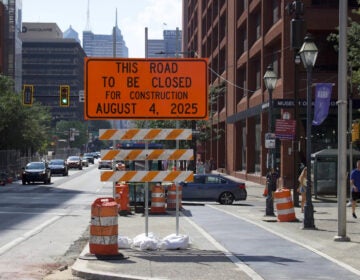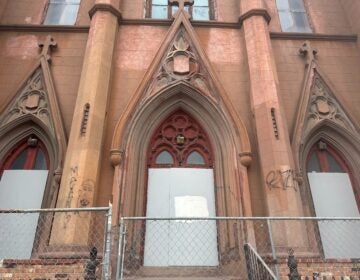CDAG discussion heats up over potential meeting with Wynn

March 11, 2010
By Kellie Patrick Gates
For PlanPhilly
The Central Delaware Advocacy Group had an at-times heated debate about whether and when members should meet with prospective Foxwoods Casino developer Steve Wynn.
During a break at a recent Harrisburg hearing where Wynn presented his ideas to the state gaming control board, the gambling mogul said he was not familiar with the Civic vision for the Central Delaware.
CDAG chair Steve Weixler wrote a letter to the editor of the Philadelphia Daily News in which he suggested that CDAG would be happy to discuss the waterfront vision with Wynn.
https://www.youtube.com/watch?v=KoYn1n6FYm8
This morning, Weixler told CDAG members that he received a phone call in response to the letter from Sen. Larry Farnese’s chief of staff, saying the senator would be willing to arrange a meeting with the Wynn organization to discuss “what they intend to build and where.” Weixler said it would be beneficial to have this kind of discussion with Wynn before his design process goes too far, since developers can be reluctant to change things when they’ve already invested significant time and money.
This morning, some members of CDAG voiced concern about such a meeting. Society Hill Civic Association president Rosanne Loesch said she was appalled at Wynn’s lack of knowledge about the Philadelphia waterfront, but she did not think it would be wise for CDAG to enlighten him. Perhaps city planning director Alan Greenberger or PennPraxis could fill Wynn in on the plan, she said. But CDAG should follow the lead of the many civic associations that pledged they would never meet with casino developers.
“The idea behind it, and I think it was very successful as a strategy, was to not give them any kind of political cover for putting themselves on the waterfront,” Loesch said.
John Scorsone, of River’s Edge Civic Association, said that part of CDAG’s very purpose is to educate developers about the vision, and advocate for development forms that fit it. He said CDAG members can advocate for or against a particular waterfront use as part of their individual civic groups, but in their role as CDAG members, they have to remember CDAG’s purpose, and push for any and all development on the waterfront to conform to the vision’s principles.
“We’ve worked very hard to keep CDAG as Switzerland,” he said. “Our role is to speak to the Steve Wynns of the world.”
Scorsone said that the Philadelphia Neighborhood Alliance – the conglomeration of civic associations that pledged never to meet with the casinos – was unsuccessful. When the neighborhood associations refused to negotiate a community benefits agreement with SugarHouse, he said, “SugarHouse just created their own civic.” Scorsone’s comment alludes to Fishtown FACT, a community group that split off from the Fishtown Neighbors Association. FACT founders and SugarHouse have denied that the casino fostered the creation of the group.
“As far as I’m concerned, the advocacy of CDAG did not succeed with SugarHouse,” said Loesch, who is a new member of CDAG. “SugarHouse is the antithesis of what this group should be (supporting),” she said, referring to the current plans for the waterfront casino, which is now under construction.
https://www.youtube.com/watch?v=JZkO9Ok4SWM
Rene Goodwin, of the Pennsport Civic Association, made a motion that CDAG not make any moves to set up a discussion with Wynn unless and until he is approved to move forward with Foxwoods at its South Philadelphia site.
After about an hour of discussion, Goodwin moved to table her own motion. Weixler said it was clear that there were still too many concerns and too much confusion for the vote to proceed. He also said he was incredulous that a proposal to do nothing for now had generated so much rancor.
https://www.youtube.com/watch?v=8kqU_Tyv3rs
In addition to casinos, CDAG discussed a topic that has confounded waterfront observers for years: Riparian lands – the riverbed lands that are owned by the state. The trickiest thing about them is that there are different takes on where the boundary line of this land lies.
Check out PlanPhilly’s explanatory Riparian Rights story
“It’s probably going to take a lawsuit to settle it,” said Loesch, who is an attorney.
Board members said the issue could prove to be very significant as the waterfront is developed. One of the key issues for landowners has been concern that the 100-foot setback requirement amounts to a taking. Board members said it may be that a significant portion of this is actually state-owned riparian land.
If it is riparian land, the city would need the legislature’s approval to use it, and they may have to pay a leasing fee.
Even that aspect has been grounds for debate, however. SugarHouse got the right to use riparian land in its project from the city Commerce Department, under the administration of John Street. SugarHouse attorneys found an old state statute they said allowed the Commerce Department to grant riparian rights, and the city’s lawyers agreed.
The Nutter administration and a cadre of local state representatives disagreed, saying that even if the law still applied, it only applied to maritime uses, and a casino didn’t count. The power to grant riparian rights lies solely with the state, they said. But the State Supreme Court upheld the Street administration’s decision, and SugarHouse kept its permit.
Subsequently, the state legislature passed new legislation saying it alone has the right to grant riparian rights.
CDAG is going to talk to some of the state elected oficials about the issue, and then plans to approach the state’s Department of General Services about putting together a map of the riparian boundary along the Delaware River in Philadelphia that would at least show where they believe that boundary lies.
CDAG members also discussed their recommendations to city planning regarding the Plan of Development process guidelines for the implementation of the Central Delaware Overlay. Read more about them here.
Weixler and a few other members met with lead planning staff to discuss the recommendations recently. (Planning is meeting with other stakeholders as well). Weixler said the meeting went very well, but how much of CDAG’s input will wind up in the regulations is yet to be seen.
To watch the whole March 11 meeting, click these links:
Contact the reporter at kelliespatrick@gmail.com
WHYY is your source for fact-based, in-depth journalism and information. As a nonprofit organization, we rely on financial support from readers like you. Please give today.






